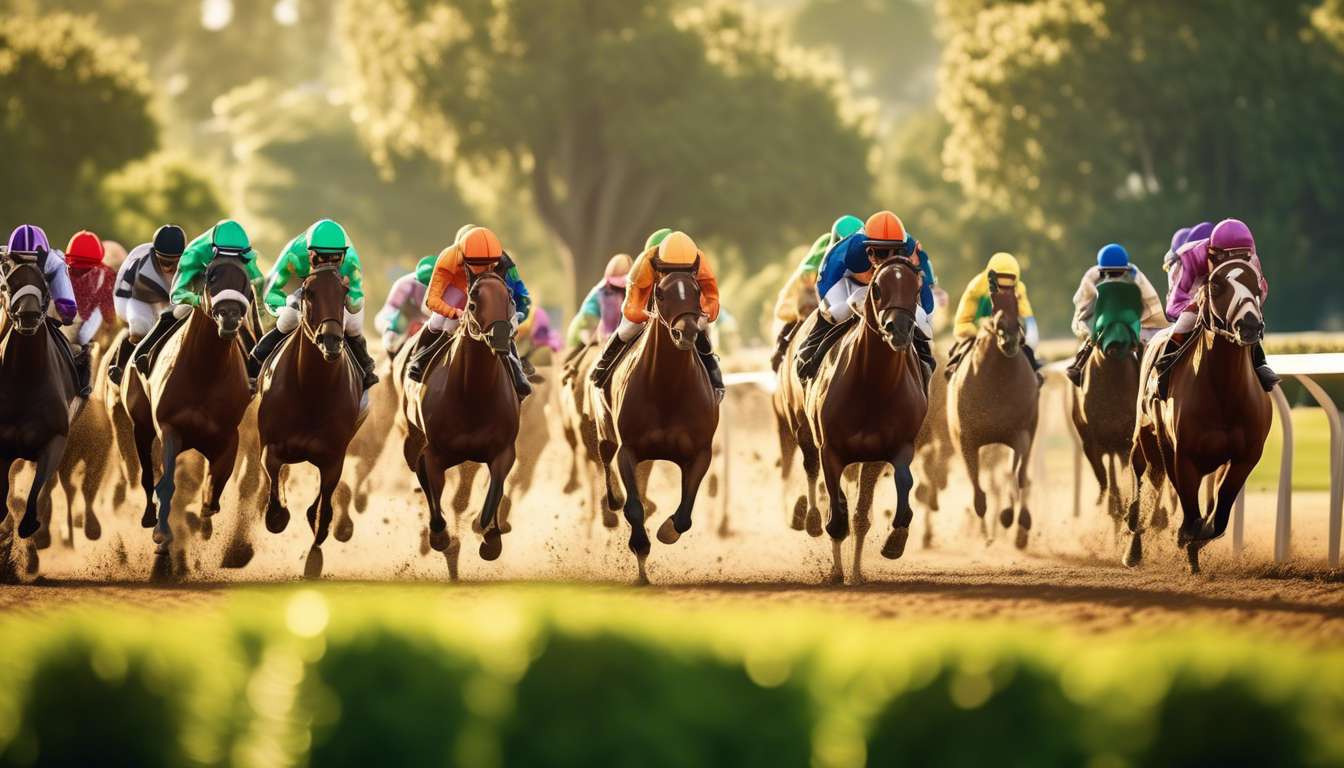In the world of horse racing, we often find ourselves pondering the intricacies that make this sport so exhilarating and unique. One such aspect that frequently captures our curiosity is the concept of a furlong. As enthusiasts and participants in this thrilling arena, we know that a furlong is more than just a unit of measurement; it is a critical component that influences strategy, race outcomes, and the very essence of the sport.
Together, we delve into understanding its significance, history, and the role it plays in crafting the narratives of each race. A furlong—equivalent to one-eighth of a mile, or 220 yards—serves as a fundamental building block in determining race lengths and tactics.
By exploring the nuances of this term, we deepen our appreciation for the precision and tradition embedded in horse racing, and we invite you to join us on this journey of exploration and discovery.
Understanding the concept of a furlong allows us to appreciate:
-
The strategic planning involved in races, as trainers and jockeys must account for the distance in their tactics.
-
The historical significance of the term, which dates back to agricultural practices, adding a layer of tradition to modern horse racing.
-
The influence on race outcomes, as the length of the race can dictate the pace and stamina required from the horses.
Join us as we explore how this seemingly simple measurement is integral to the sport’s charm and complexity.
The Origins of the Furlong
The term "furlong" originated from the Old English words "furh" and "lang," meaning the length of a furrow in a plowed field. This historical unit of measurement has deep roots in agriculture, where it initially measured the distance a team of oxen could plow without resting.
In the world of horse racing, a furlong has transcended its agricultural origins to become an integral part of the sport. It serves as:
- A unit of distance
- A piece of our shared language
- A marker of our races that unites us in anticipation and excitement
When we gather at the track, we don’t just watch horses race; we cheer them on over every furlong, understanding the significance of each stride.
By celebrating this tradition, we strengthen our bond as a community, united by our love for the sport and its rich history.
Furlong Measurement Explained
In understanding the measurement of a furlong, we recognize it as equivalent to one-eighth of a mile, or precisely 220 yards. This unit of measurement is deeply ingrained in the world of horse racing, where it helps define the distance of various races.
By connecting with this traditional unit, we join a community that appreciates the rich history and precision that furlongs bring to the sport.
When we follow horse races, knowing the furlong distance allows us to appreciate the strategy involved. Horses and jockeys must adapt their pace and tactics based on the length of the race, making each event unique.
As fans, understanding these distances enhances our connection to the sport and the excitement of each race.
The use of furlongs in horse racing isn’t just about tradition; it’s about creating a shared experience. By speaking this language, we’re embracing a sense of belonging in a vibrant community that cherishes accuracy and excitement in every stride.
Furlong vs. Other Racing Distances
When we compare furlongs to other racing distances, we see how they uniquely influence race strategy and excitement. In horse racing, the furlong, which measures an eighth of a mile, often sets the stage for thrilling sprints and tactical maneuvers.
Furlong races demand:
- Quick acceleration
- Swift decision-making
We, as spectators and enthusiasts, relish the burst of energy and the anticipation that comes with these shorter races.
In contrast, races spanning multiple furlongs or even miles allow us to witness the endurance and strategy of both horse and jockey. Each distance tests different aspects of skill and stamina, making us appreciate the variety that horse racing offers.
The diversity in race distances creates a sense of belonging within the community, as each of us might have a preference for a particular type of race. Whether it’s the electrifying sprint of a single furlong or the strategic dance of a longer race, the variety enriches our shared experience.
Furlongs in Different Types of Races
In various types of races, furlongs dictate the pace and strategy, whether it’s a short sprint or a longer endurance challenge. In horse racing, the furlong serves as a crucial measurement of distance.
For shorter races, typically around five or six furlongs, speed becomes the primary focus. We feel the excitement as these sprints demand that both horse and jockey push their limits right from the start.
On the other hand, when we dive into races longer than a mile, which includes several furlongs, endurance takes center stage. Here, pacing is everything, and we appreciate the skillful balance between speed and stamina. Watching these races, we find ourselves united in awe of the horses as they gracefully cover the distance, each furlong marking their progress.
Whether it’s the thrill of a quick dash or the suspense of a long haul, furlongs shape our shared passion for the sport, connecting us through every exhilarating race.
Furlong’s Role in Race Tactics
Race tactics are heavily influenced by the number of furlongs, dictating whether jockeys should focus on raw speed or strategic pacing. As we gather at the track, the excitement in the air is palpable.
In horse racing, understanding the distance of a race is crucial for us to feel like we’re part of the action.
-
Shorter races, perhaps around six furlongs, demand a burst of speed right from the start. Our hearts race as the horses burst out of the gate, jockeys urging them to lead early.
-
Longer races, of ten furlongs or more, require a careful balance. We watch as jockeys expertly manage energy, pacing their mounts to conserve strength for a powerful finish.
This interplay between furlong and distance shapes how we perceive and enjoy the sport. As fans, our connection to horse racing deepens when we grasp the nuances of each race, feeling like insiders to the thrilling world of furlong dynamics.
Furlong’s Impact on Race Strategy
In horse racing, the race distance measured in furlongs significantly influences the strategies employed by jockeys. The number of furlongs determines when to push for speed or hold back for a strong finish.
Shorter Races:
- Typically just a few furlongs in length.
- Require a quick burst of speed right from the start.
- Conserving energy isn’t an option.
- Emphasis is on explosive power and maintaining it over a shorter distance.
Longer Races:
- Demand patience and strategic pacing.
- Jockeys must decide the optimal moment to accelerate.
- Essential to ensure the horse has enough stamina for the final stretch.
- The challenge is balancing speed and endurance, making each furlong count.
As spectators, we feel the tension, knowing that each decision made by the jockey could lead to victory or defeat. Understanding these strategies fosters a deeper connection with the sport, enhancing our appreciation for the skill and tactics behind each race.
Furlong’s Historical Evolution
Over centuries, we’ve seen the furlong evolve from an agricultural measurement to a crucial unit in the thrilling world of horse racing. Originally, a furlong represented the length of a furrow in a plowed field, roughly 220 yards. As communities grew and shared traditions, the need for a standardized unit of distance became apparent, especially as horse racing emerged as a popular sport.
In the early days of horse racing, using furlongs allowed everyone—from jockeys to spectators—to grasp the race’s length, fostering a sense of unity and excitement. The familiar rhythm of furlongs quickly became a part of our shared racing culture. This measurement, once tied to farming, seamlessly transitioned to define race distances, embedding itself in the sport’s very fabric.
As we gather at the track, the furlong connects us to a rich history. It reminds us of a time when practicality met passion, creating the foundation for the exhilarating races we cherish today.
Furlong’s Significance in Modern Racing
In today’s racing world, the furlong is a fundamental unit that enhances both strategy and spectator excitement.
Horse racing is all about precision and pacing, and the furlong—an eighth of a mile—offers a unique way to measure these races. By understanding each furlong’s distance, we can better appreciate the strategy behind each stride.
Key aspects of furlongs in racing include:
- Explosive speed at the start
- Calculated stamina needed for longer distances
Each segment plays a pivotal role in the race.
Together, we gather at the tracks, feeling the collective thrill as horses thunder past each furlong marker. The furlong becomes more than just a measure; it becomes part of our shared experience.
The furlong serves as a universal language, understood by:
- Seasoned bettors
- Newcomers eager to learn
We engage in discussions, analyzing how each furlong impacts the race’s outcome. In this way, the furlong remains integral, connecting us through the timeless excitement of horse racing.
Conclusion
In conclusion, understanding the furlong in horse racing is crucial for grasping the dynamics of the sport.
From its historical origins to its role in modern race tactics, the furlong plays a significant part in determining race strategy and outcomes.
Whether you’re a seasoned racing enthusiast or a newcomer to the sport, knowing the importance of the furlong will enhance your appreciation for the intricacies of horse racing.

